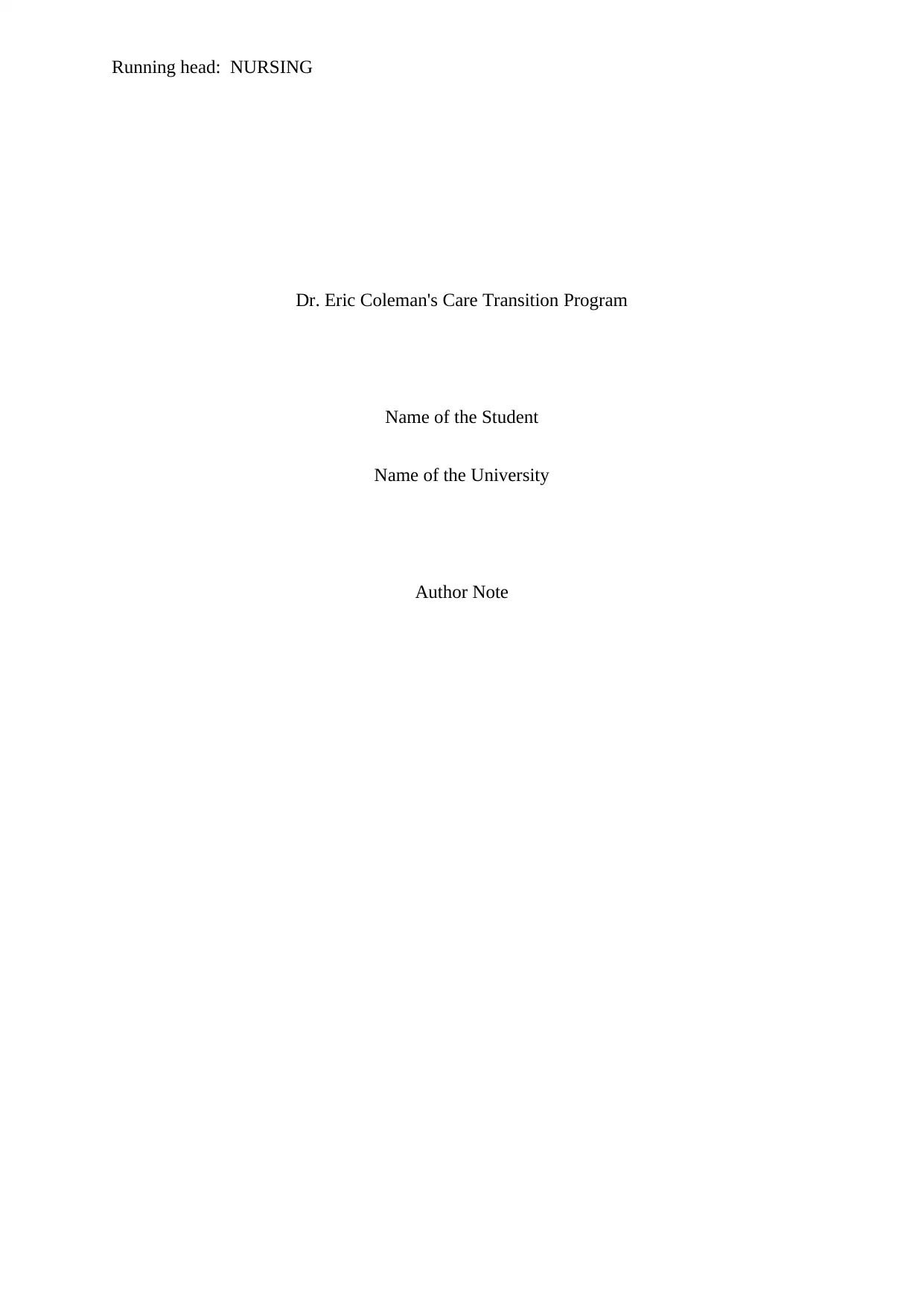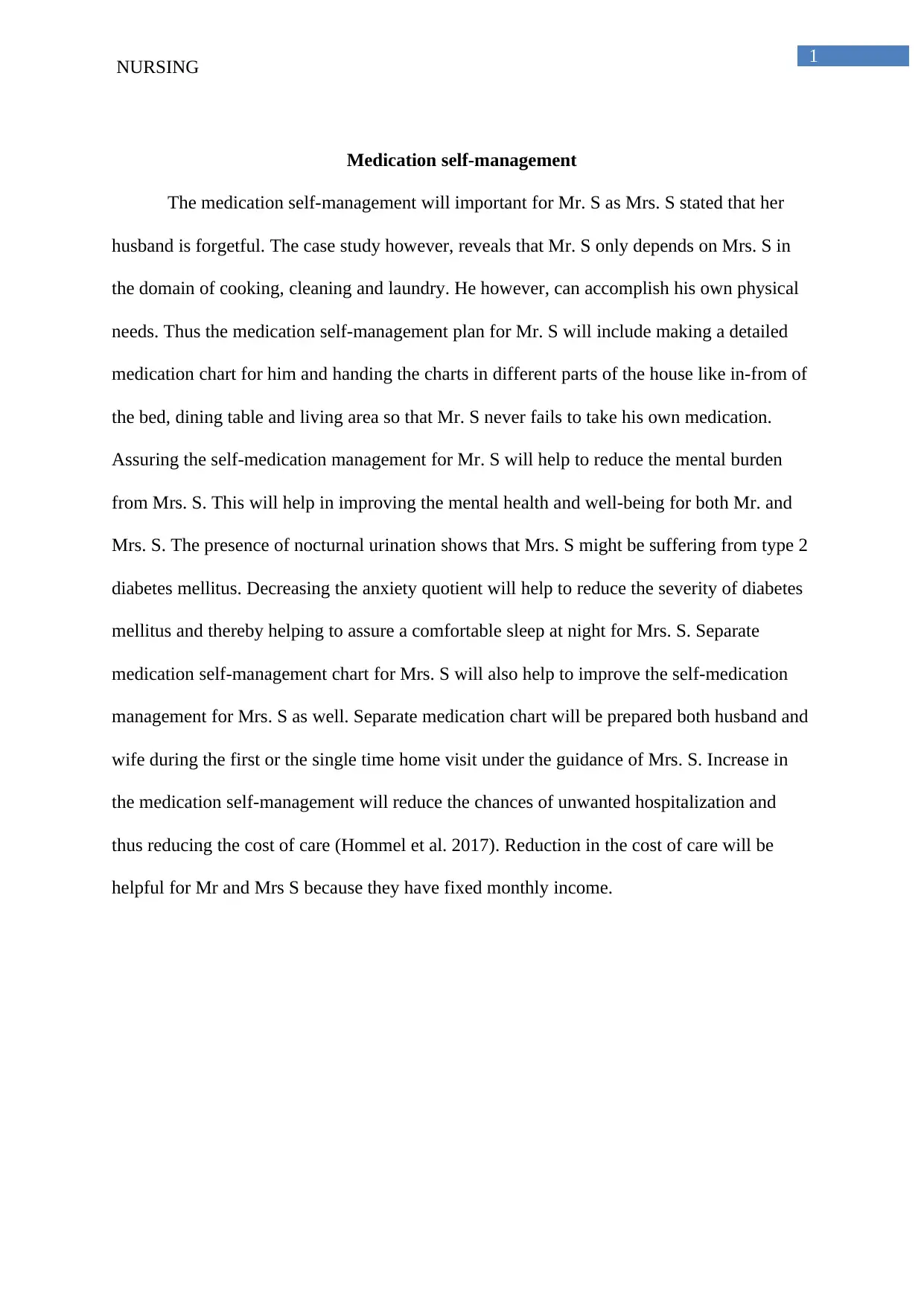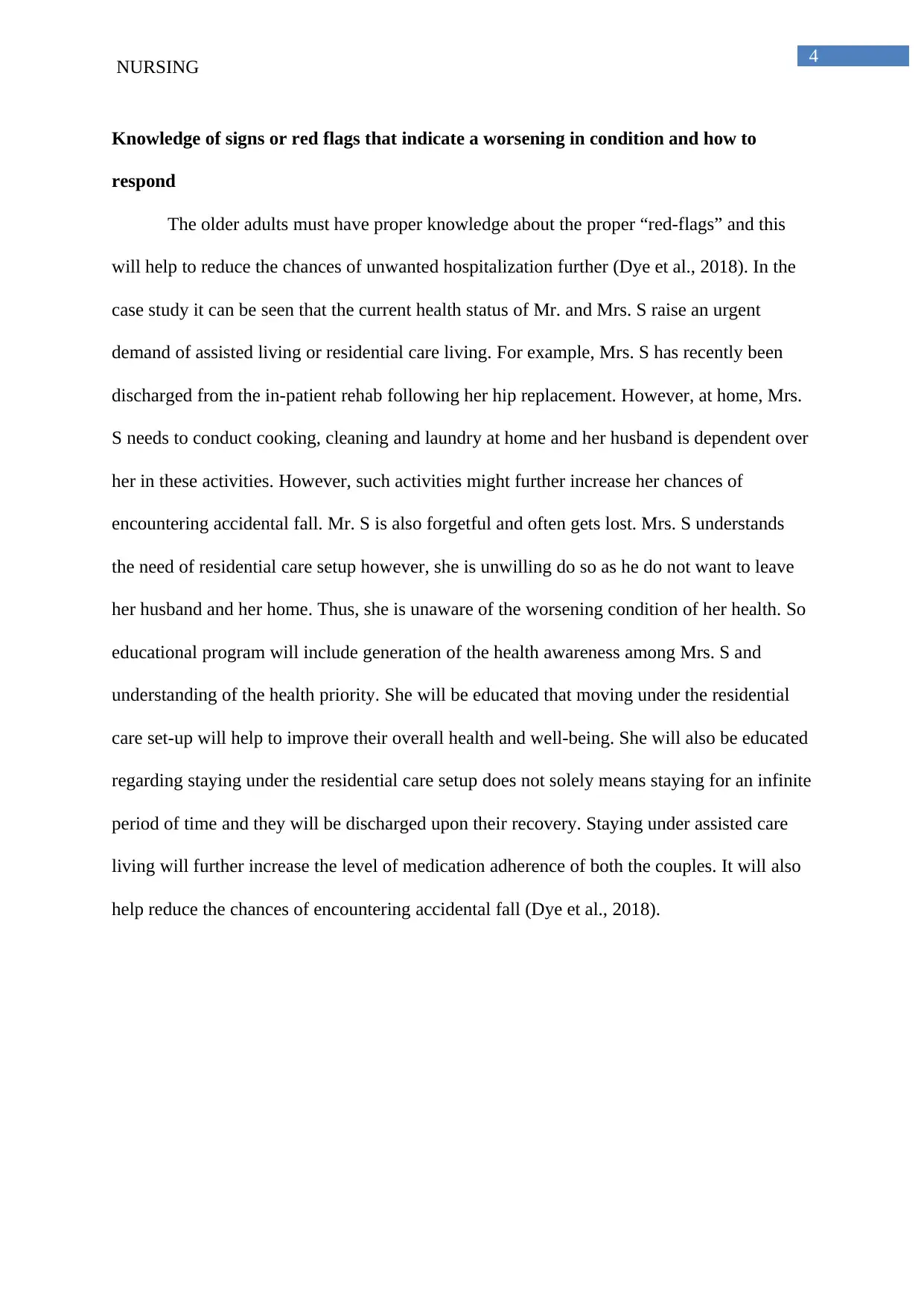Analysis of Dr. Eric Coleman's Care Transition Program in Nursing
VerifiedAdded on 2022/09/14
|6
|1390
|19
Report
AI Summary
This nursing report analyzes Dr. Eric Coleman's Care Transition Program, focusing on a case study involving Mr. and Mrs. S. The report emphasizes medication self-management, including creating detailed medication charts and ensuring adherence to reduce the burden on caregivers and improve overall well-being. It also highlights the use of patient-centered records and personal health records to generate individualized care plans, such as diet plans and occupational therapy. Furthermore, the report underscores the importance of timely primary and specialty care follow-ups, knowledge of warning signs, and educational programs to improve the health outcomes of older adults and reduce the risk of hospitalization. The report also discusses community-based healthcare checkups and triage nursing to provide accessible care for the geriatric couple. The report suggests the need for residential care setup and the importance of education regarding the benefits of assisted living. The report also suggests that proper intervention strategies, including medication management, patient-centered care, and timely follow-ups are essential for the well-being of the elderly.

Running head: NURSING
Dr. Eric Coleman's Care Transition Program
Name of the Student
Name of the University
Author Note
Dr. Eric Coleman's Care Transition Program
Name of the Student
Name of the University
Author Note
Paraphrase This Document
Need a fresh take? Get an instant paraphrase of this document with our AI Paraphraser

1
NURSING
Medication self-management
The medication self-management will important for Mr. S as Mrs. S stated that her
husband is forgetful. The case study however, reveals that Mr. S only depends on Mrs. S in
the domain of cooking, cleaning and laundry. He however, can accomplish his own physical
needs. Thus the medication self-management plan for Mr. S will include making a detailed
medication chart for him and handing the charts in different parts of the house like in-from of
the bed, dining table and living area so that Mr. S never fails to take his own medication.
Assuring the self-medication management for Mr. S will help to reduce the mental burden
from Mrs. S. This will help in improving the mental health and well-being for both Mr. and
Mrs. S. The presence of nocturnal urination shows that Mrs. S might be suffering from type 2
diabetes mellitus. Decreasing the anxiety quotient will help to reduce the severity of diabetes
mellitus and thereby helping to assure a comfortable sleep at night for Mrs. S. Separate
medication self-management chart for Mrs. S will also help to improve the self-medication
management for Mrs. S as well. Separate medication chart will be prepared both husband and
wife during the first or the single time home visit under the guidance of Mrs. S. Increase in
the medication self-management will reduce the chances of unwanted hospitalization and
thus reducing the cost of care (Hommel et al. 2017). Reduction in the cost of care will be
helpful for Mr and Mrs S because they have fixed monthly income.
NURSING
Medication self-management
The medication self-management will important for Mr. S as Mrs. S stated that her
husband is forgetful. The case study however, reveals that Mr. S only depends on Mrs. S in
the domain of cooking, cleaning and laundry. He however, can accomplish his own physical
needs. Thus the medication self-management plan for Mr. S will include making a detailed
medication chart for him and handing the charts in different parts of the house like in-from of
the bed, dining table and living area so that Mr. S never fails to take his own medication.
Assuring the self-medication management for Mr. S will help to reduce the mental burden
from Mrs. S. This will help in improving the mental health and well-being for both Mr. and
Mrs. S. The presence of nocturnal urination shows that Mrs. S might be suffering from type 2
diabetes mellitus. Decreasing the anxiety quotient will help to reduce the severity of diabetes
mellitus and thereby helping to assure a comfortable sleep at night for Mrs. S. Separate
medication self-management chart for Mrs. S will also help to improve the self-medication
management for Mrs. S as well. Separate medication chart will be prepared both husband and
wife during the first or the single time home visit under the guidance of Mrs. S. Increase in
the medication self-management will reduce the chances of unwanted hospitalization and
thus reducing the cost of care (Hommel et al. 2017). Reduction in the cost of care will be
helpful for Mr and Mrs S because they have fixed monthly income.

2
NURSING
Use of a dynamic patient-centered record, the personal health record that has patient-
related clinically relevant information in an easy-to-comprehend format
The patient-centered record and personal health record along with patient-related
clinically relevant information will be used to generate a person-centered care plan for Mrs.
S. This person centered care plan for Mrs. S will focus on generation of patient centered diet
plan for Mrs. S. the patient-centered diet plan for Mrs. S will take into consideration of the
drastic weight-loss of Mrs. S, her cardiac health condition (as she had previous medical
history of heart attack) and her condition of nocturnal urination and sleep apnea. Following a
proper diet plan will help the Mr. S to improve the overall health-condition. The preparation
of the diet planning will be done under the presence of a trained yet professional dietician
(Cioara et al., 2018). Mrs. S was admitted to the hospital following an accidental fall at home
that resulted in the hip fracture. Thus person-centered care plan for Mrs. S will include proper
occupational care planning in order to reduce the chances of accidental fall. The easy to
comprehend diet plan will help to improve the overall physical health. The easy to
comprehend health-format will help Mrs S to abide easily abide by the healthy life-
interventions and thereby helping to promote health and well-being. The diet plan will be
mailed to Mrs. S following her home visit with proper tabulation of the daily diet chart in
proper ratio and she will be asked to list the chart in front of kitchen. The occupational
therapy plan will mainly focus on proper indoor lightening, proper arrangement of the
upholstery and use of high traction shows.
NURSING
Use of a dynamic patient-centered record, the personal health record that has patient-
related clinically relevant information in an easy-to-comprehend format
The patient-centered record and personal health record along with patient-related
clinically relevant information will be used to generate a person-centered care plan for Mrs.
S. This person centered care plan for Mrs. S will focus on generation of patient centered diet
plan for Mrs. S. the patient-centered diet plan for Mrs. S will take into consideration of the
drastic weight-loss of Mrs. S, her cardiac health condition (as she had previous medical
history of heart attack) and her condition of nocturnal urination and sleep apnea. Following a
proper diet plan will help the Mr. S to improve the overall health-condition. The preparation
of the diet planning will be done under the presence of a trained yet professional dietician
(Cioara et al., 2018). Mrs. S was admitted to the hospital following an accidental fall at home
that resulted in the hip fracture. Thus person-centered care plan for Mrs. S will include proper
occupational care planning in order to reduce the chances of accidental fall. The easy to
comprehend diet plan will help to improve the overall physical health. The easy to
comprehend health-format will help Mrs S to abide easily abide by the healthy life-
interventions and thereby helping to promote health and well-being. The diet plan will be
mailed to Mrs. S following her home visit with proper tabulation of the daily diet chart in
proper ratio and she will be asked to list the chart in front of kitchen. The occupational
therapy plan will mainly focus on proper indoor lightening, proper arrangement of the
upholstery and use of high traction shows.
⊘ This is a preview!⊘
Do you want full access?
Subscribe today to unlock all pages.

Trusted by 1+ million students worldwide

3
NURSING
Timely primary care/specialty care follow-up based on empirical research
The timely primary care/specialty care follow-up is based on empirical research
highlights that regular access of the primary care among the older adults. Periodic access to
the primary healthcare setup helps in early identification of the patients’ health alignments or
other healthcare priorities and thereby helping in the early implementation of the healthcare
interventions and thereby helping reduce the chances of unwanted hospital admission due to
chronic health complications (Brown, 2018). Increased and timely access to the primary care
will help Mrs. S to reduce her chances of being registered under the residential care set-up. It
will also reduce the chances of husband in being admitted in the nursing home with poor
healthcare condition. As per the case study, Mr. S might be suffering from the initial stage of
dementia, as he is forgetful. Regular check-up neurological condition of Mr. S along with
proper medication management will reduce the unwanted chances of hospitalization. The
follow-up for the Mr. and Mrs. S under the primary healthcare provider will be done on
month basis and the remainder will be sent through phone calls while helping the couple to
set reminder over their phone. Apart from the primary care service, the couple will be
assigned under the community-based healthcare checkup run by the NGOs (non-
governmental organization). The community-based healthcare checkups points are mainly
located near the locality in comparison to the primary healthcare checkup centers and thus
helping the geriatric couple to get instant access. Triage nursing can also be followed during
sudden emergency at the odd hours of the day and this will further reduce the chances of
unwanted hospitalization.
NURSING
Timely primary care/specialty care follow-up based on empirical research
The timely primary care/specialty care follow-up is based on empirical research
highlights that regular access of the primary care among the older adults. Periodic access to
the primary healthcare setup helps in early identification of the patients’ health alignments or
other healthcare priorities and thereby helping in the early implementation of the healthcare
interventions and thereby helping reduce the chances of unwanted hospital admission due to
chronic health complications (Brown, 2018). Increased and timely access to the primary care
will help Mrs. S to reduce her chances of being registered under the residential care set-up. It
will also reduce the chances of husband in being admitted in the nursing home with poor
healthcare condition. As per the case study, Mr. S might be suffering from the initial stage of
dementia, as he is forgetful. Regular check-up neurological condition of Mr. S along with
proper medication management will reduce the unwanted chances of hospitalization. The
follow-up for the Mr. and Mrs. S under the primary healthcare provider will be done on
month basis and the remainder will be sent through phone calls while helping the couple to
set reminder over their phone. Apart from the primary care service, the couple will be
assigned under the community-based healthcare checkup run by the NGOs (non-
governmental organization). The community-based healthcare checkups points are mainly
located near the locality in comparison to the primary healthcare checkup centers and thus
helping the geriatric couple to get instant access. Triage nursing can also be followed during
sudden emergency at the odd hours of the day and this will further reduce the chances of
unwanted hospitalization.
Paraphrase This Document
Need a fresh take? Get an instant paraphrase of this document with our AI Paraphraser

4
NURSING
Knowledge of signs or red flags that indicate a worsening in condition and how to
respond
The older adults must have proper knowledge about the proper “red-flags” and this
will help to reduce the chances of unwanted hospitalization further (Dye et al., 2018). In the
case study it can be seen that the current health status of Mr. and Mrs. S raise an urgent
demand of assisted living or residential care living. For example, Mrs. S has recently been
discharged from the in-patient rehab following her hip replacement. However, at home, Mrs.
S needs to conduct cooking, cleaning and laundry at home and her husband is dependent over
her in these activities. However, such activities might further increase her chances of
encountering accidental fall. Mr. S is also forgetful and often gets lost. Mrs. S understands
the need of residential care setup however, she is unwilling do so as he do not want to leave
her husband and her home. Thus, she is unaware of the worsening condition of her health. So
educational program will include generation of the health awareness among Mrs. S and
understanding of the health priority. She will be educated that moving under the residential
care set-up will help to improve their overall health and well-being. She will also be educated
regarding staying under the residential care setup does not solely means staying for an infinite
period of time and they will be discharged upon their recovery. Staying under assisted care
living will further increase the level of medication adherence of both the couples. It will also
help reduce the chances of encountering accidental fall (Dye et al., 2018).
NURSING
Knowledge of signs or red flags that indicate a worsening in condition and how to
respond
The older adults must have proper knowledge about the proper “red-flags” and this
will help to reduce the chances of unwanted hospitalization further (Dye et al., 2018). In the
case study it can be seen that the current health status of Mr. and Mrs. S raise an urgent
demand of assisted living or residential care living. For example, Mrs. S has recently been
discharged from the in-patient rehab following her hip replacement. However, at home, Mrs.
S needs to conduct cooking, cleaning and laundry at home and her husband is dependent over
her in these activities. However, such activities might further increase her chances of
encountering accidental fall. Mr. S is also forgetful and often gets lost. Mrs. S understands
the need of residential care setup however, she is unwilling do so as he do not want to leave
her husband and her home. Thus, she is unaware of the worsening condition of her health. So
educational program will include generation of the health awareness among Mrs. S and
understanding of the health priority. She will be educated that moving under the residential
care set-up will help to improve their overall health and well-being. She will also be educated
regarding staying under the residential care setup does not solely means staying for an infinite
period of time and they will be discharged upon their recovery. Staying under assisted care
living will further increase the level of medication adherence of both the couples. It will also
help reduce the chances of encountering accidental fall (Dye et al., 2018).

5
NURSING
References
Brown, M. M. (2018). Transitions of care. In Chronic Illness Care (pp. 369-373). Springer,
Cham.
Cioara, T., Anghel, I., Salomie, I., Barakat, L., Miles, S., Reidlinger, D., ... & Pop, F. (2018).
Expert system for nutrition care process of older adults. Future Generation Computer
Systems, 80, 368-383.
Dye, C., Willoughby, D., Aybar-Damali, B., Grady, C., Oran, R., & Knudson, A. (2018).
Improving chronic disease self-management by older home health patients through
community health coaching. International journal of environmental research and
public health, 15(4), 660.
Hommel, K. A., McGrady, M. E., Peugh, J., Zacur, G., Loreaux, K., Saeed, S., ... & Denson,
L. A. (2017). Longitudinal patterns of medication nonadherence and associated health
care costs. Inflammatory bowel diseases, 23(9), 1577-1583.
NURSING
References
Brown, M. M. (2018). Transitions of care. In Chronic Illness Care (pp. 369-373). Springer,
Cham.
Cioara, T., Anghel, I., Salomie, I., Barakat, L., Miles, S., Reidlinger, D., ... & Pop, F. (2018).
Expert system for nutrition care process of older adults. Future Generation Computer
Systems, 80, 368-383.
Dye, C., Willoughby, D., Aybar-Damali, B., Grady, C., Oran, R., & Knudson, A. (2018).
Improving chronic disease self-management by older home health patients through
community health coaching. International journal of environmental research and
public health, 15(4), 660.
Hommel, K. A., McGrady, M. E., Peugh, J., Zacur, G., Loreaux, K., Saeed, S., ... & Denson,
L. A. (2017). Longitudinal patterns of medication nonadherence and associated health
care costs. Inflammatory bowel diseases, 23(9), 1577-1583.
⊘ This is a preview!⊘
Do you want full access?
Subscribe today to unlock all pages.

Trusted by 1+ million students worldwide
1 out of 6
Related Documents
Your All-in-One AI-Powered Toolkit for Academic Success.
+13062052269
info@desklib.com
Available 24*7 on WhatsApp / Email
![[object Object]](/_next/static/media/star-bottom.7253800d.svg)
Unlock your academic potential
Copyright © 2020–2025 A2Z Services. All Rights Reserved. Developed and managed by ZUCOL.





